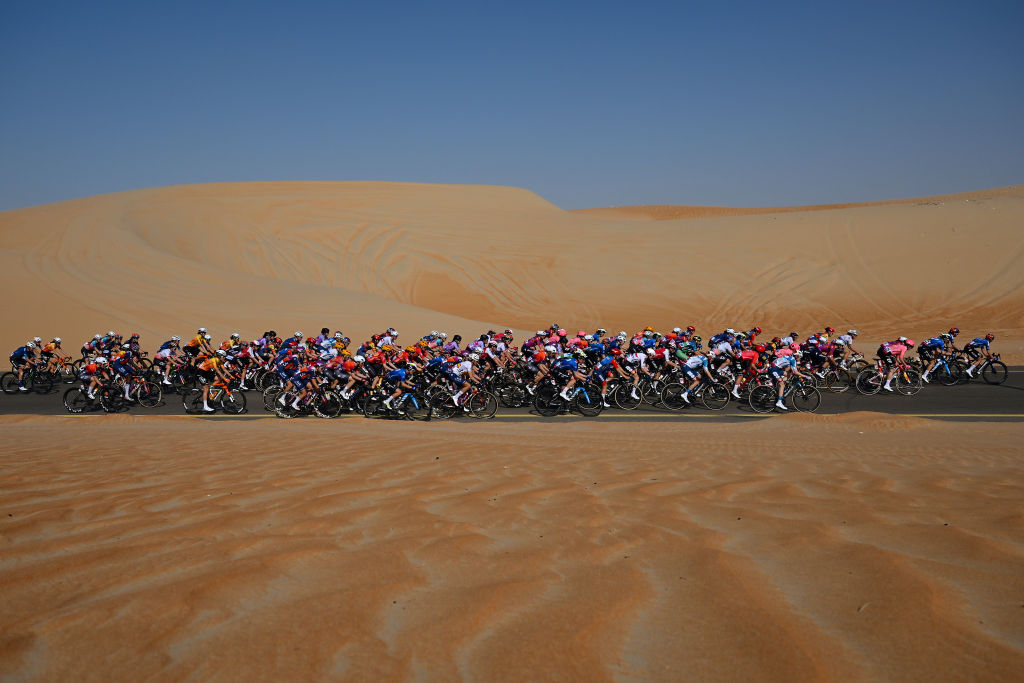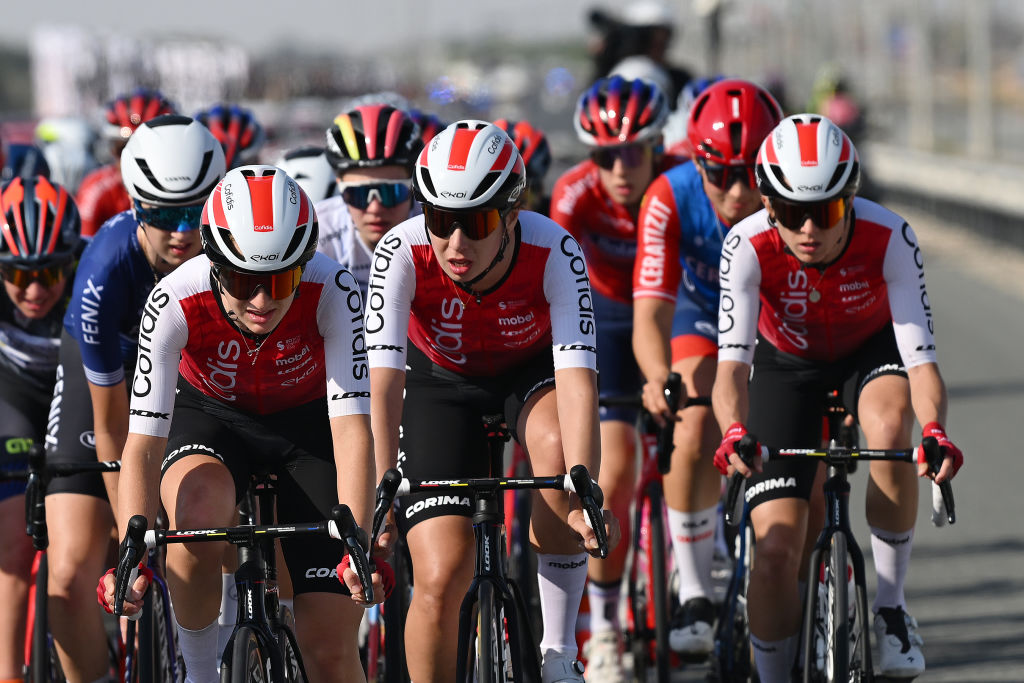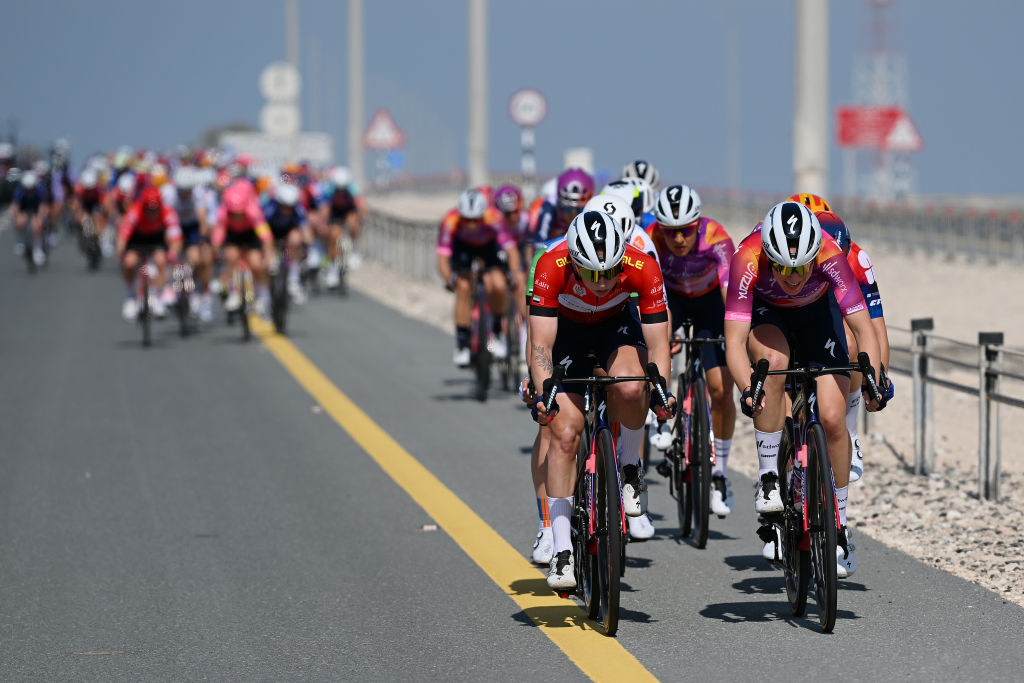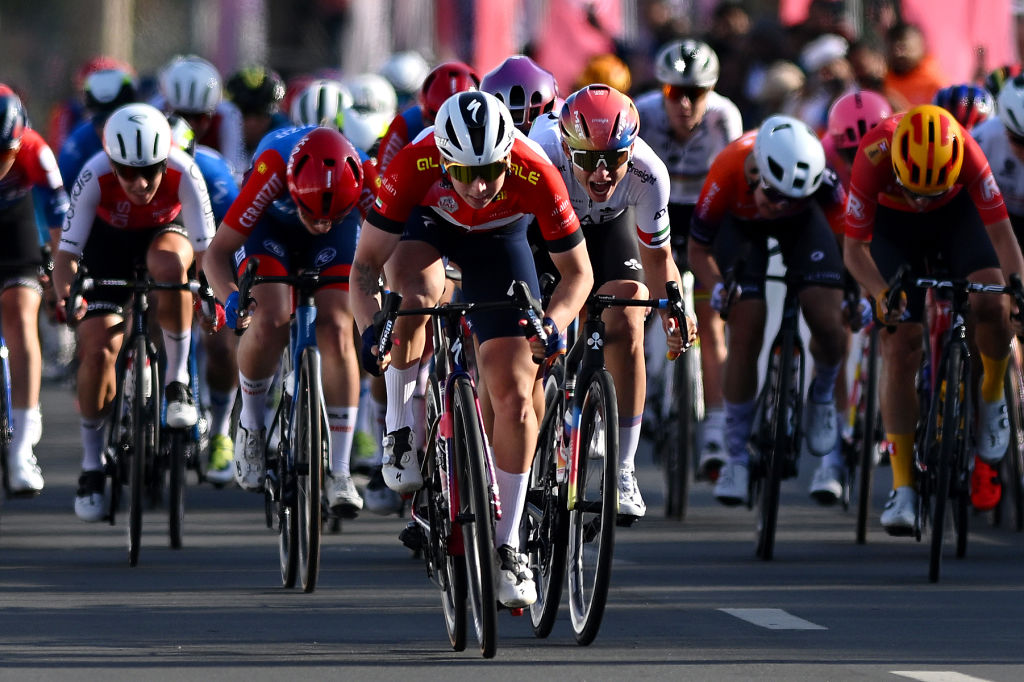Echelons, punctures, sand dunes and sprints – Inside the UAE Tour Women convoy
Cyclingnews reporter Lukas Knöfler spends a day inside the team caravan through the windswept desert between Al Mirfa and Madinat Zayed

Stage 2 of the UAE Tour Women was held in the Al Dhafra Region, which makes up about of the country’s area but is very thinly inhabited and quite far from the urban centres of Dubai, Al Ain, and Abu Dhabi, which host the other three stages.
The drive to the start in Al Mirfa took about 90 minutes, and so does the drive back from Madinat Zayed that we are currently on. The sun is still shining brightly above the desert, but by the time we’re in Abu Dhabi, it will be long past sunset, and the light has made way for almost pitch-black darkness.
When we arrived at the start venue just before noon, there was a bit of wind, though nothing like the gusts at the pre-race press conference on Hudayriyat Island on Wednesday. And it looked like the wind direction was a bit too northerly to be ideal for echelons. But hope dies last, right?
While walking the team parking lot, I was invited to ride along in the Cofidis car by the team’s sports director, Arthur Quilliec – and that’s not something you say no to, least of all on a stage that might just explode into echelons in the desert. So, after completing my interviews at the start, I walked back to the French team’s camp to meet up with Arthur and the team mechanic Jérôme, my company, for the next couple of hours.
Waiting for the start, we talk about the venue – right by the sea and with various amenities, the area is nonetheless very empty, giving the feel of a recently-completed housing development that is still waiting for its residents to move in. We do pass older and more inhabited parts of Al Mirfa in the neutral zone, though, and locals were looking on outside their shops and cafés as the women’s peloton made its way through.
The neutral zone ended up being a bit longer than planned because a rider had punctured, and the race waited for her to return before the flag was waved. The rider was chasing back on the bumper of her team car that was going past the convoy in the left lane at high speed, causing Arthur to shake his head: “That is so dangerous! All you need is a car pulling left or braking suddenly, and you have a really bad crash. I wouldn’t do this, I want my riders to stay alive,” he said only half-jokingly.
This was the first of a number of punctures throughout the day. Every so often, the race radio would creak into action, announce the team in question and, if the mechanic was lucky, whether it was the front or the rear wheel that needed changing, prompting a mad dash by the team car to assist their rider. The Cofidis riders were spared any punctures, meaning that Jérôme could enjoy somewhat of a break in between getting the bikes ready for the race and checking them for any faults after the stage.
Get The Leadout Newsletter
The latest race content, interviews, features, reviews and expert buying guides, direct to your inbox!

As the race trundled along the roads around Al Mirfa at a leisurely pace, we settled into a relaxed silence, waiting for the turn to the south and into the open desert. Eventually, a front echelon formed in the tail-crosswind that included Lotte Kopecky, Lorena Wiebes, their SD Worx-Protime teammates Barbara Guarischi and Femke Markus as well as Emma Norsgaard (Movistar Team), Loes Adegeest (FDJ-SUEZ), Rachele Barbieri, Pfeiffer Georgi (both Team dsm-firmenich PostNL), Wilma Olausson (Uno-X Mobility), Romy Kasper (Human Powered Health) and riders from Liv-AlUla-Jayco and Team Coop-Repsol.
Behind all this, Morgane Coston (Cofidis) had been dropped from the peloton, making Arthur grab the team radio transmitter and inform the rest of the riders and give Coston some encouragement.
Speaking of team radios: To me, the transmissions that reached us in the car sounded very similar to the parents in Peanuts clips, a stringing together of sounds rather than distinct words. It can’t be easy to make yourself clear when you are trying to keep your position in the peloton and simultaneously speak into a small microphone while trying to shield it from the wind – but I guess if you’re driving team cars every week, you will eventually get used to it and understand what your riders are asking for.
When Kopecky punctured out of the lead group, the echelon action was soon over, and many riders will have breathed a sigh of relief as the race then settled into a fast, but steady rhythm. There would be no more echelons as the wind was now a tailwind for most of the rest of the stage, apart from the 11-kilometre finishing straight (that’s not a typo).
Other than Hannah Ludwig dropping back to the car to pick up bottles and ice socks – a decades-old but very functional contraption of an ice-cube-filled nylon sock with the opening tied together – it was an uneventful day, leaving room to look out of the window as the desert landscape passed by.

There were some sand dunes, and the wind blew the sand across the road, showing that the stage could have been total carnage if the wind direction had been just a little different, but the desert mainly consisted of compacted sand with bushes and brushes and the occasional small saltpan.
More conspicuous were man-made objects like motorway bridges (the two hardest climbs of the day) or oil rigs (the Al Dhafra Region holds most of the UAE oil reserves), and the electrical power lines that seemed to be everywhere. Or maybe it just felt that way because there was nothing else, and they were visible from kilometres away. As we closed in on Madinat Zayed, we saw two camps with camels, too.
The technical section through the desert town followed by an out-and-back run, first south on the big road out of town, then back north to the finish line, made Arthur announce the various turns and roundabouts before giving last instructions to Valentine Fortin and her lead-out Martina Alzini in his calm and supportive manner: “There is a full-on headwind, you want to sprint on the right side. You know what to do, allez, allez!”
As the race entered the final kilometres, the Cofidis train came through to the front in the middle of the road and going into the last 500 metres, Alzini and Fortin were positioned very well, but in the end, Fortin got boxed in and finished in 12th place.
Diverting off the race route, we got to the team parking lot just before the riders arrived. After thanking Arthur and Jérôme for the ride, I moved back into my ‘regular job’ of interviewing riders and sports directors.

Lukas Knöfler started working in cycling communications in 2013 and has seen the inside of the scene from many angles. Having worked as press officer for teams and races and written for several online and print publications, he has been Cyclingnews’ Women’s WorldTour correspondent since 2018.